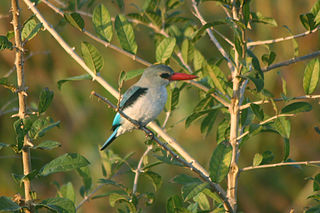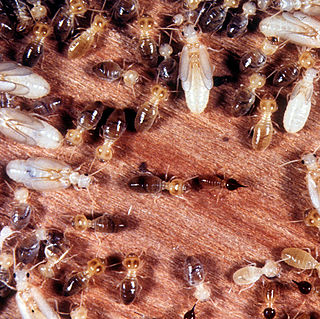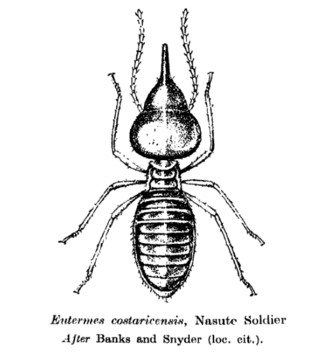Fibrobacterota is a small bacterial phylum which includes many of the major rumen bacteria, allowing for the degradation of plant-based cellulose in ruminant animals. Members of this phylum were categorized in other phyla. The genus Fibrobacter was removed from the genus Bacteroides in 1988.

Eupsittula canicularis, also known as the orange-fronted parakeet, orange-fronted conure, half-moon conure or Petz's conure is a Vulnerable species of bird in subfamily Arinae of the family Psittacidae, the African and New World parrots. It is found from western Mexico to Costa Rica.

The white-throated round-eared bat is a bat species found from Honduras to Bolivia, Paraguay and Brazil. It creates roosts inside the nests of the termite, Nasutitermes corniger. It thrives on a mainly insect-based diet, focusing on the surfaces of foliage to hunt, and also eats fruit and pollen. It has a very wide range and is a common species over much of that range, so the International Union for Conservation of Nature has assessed its conservation status as being of "least concern".

The mangrove kingfisher is a kingfisher in the genus Halcyon. It is similar in appearance to the woodland kingfisher. It is found along the eastern coastline of Sub-Saharan Africa, living in woodland, along rivers, and in estuaries and mangrove. The International Union for Conservation of Nature (IUCN) has assessed it as being of least concern.

The chocolate-backed kingfisher is a species of kingfisher in the subfamily Halcyoninae which occurs in western Sub-Saharan Africa.

Nasutitermes corniger is a species of arboreal termite that is endemic to the neotropics. It is very closely related to Nasutitermes ephratae. The species has been studied relatively intensively, particularly on Barro Colorado Island, Panama. These studies and others have shown that the termite interacts with many different organisms including a bat that roosts in its nest and various species of ants that cohabit with the termite.
Sporomusa termitida is a species of bacteria. It is an acetogen first isolated from termites. Its cells are strictly anaerobic, Gram-negative, endospore-forming, straight to slightly curved rods that are motile by means of lateral flagella.

Nasutitermes walkeri, commonly known as the tree termite, is a species of arboreal termite found in eastern New South Wales and southeastern Queensland, Australia.

Nasutitermes is a species of snouted termite occurring in Australia. It is common in Canberra and parts of New South Wales. It nests in soil. Spores of Metarhizium robertsii have been found in their mounds.

Nasutitermes triodiae, also known as the cathedral termite, is a grass-eating species of Nasutitermitinae termite that can be found in Northern Territory, Australia. It is also sometimes referred to as the spinifex termite, since it is found in the spinifex grasslands. Very little research has been done on the underground nature of this species.

Macrotermes is a genus of termites belonging to the subfamily Macrotermitinae and widely distributed throughout Africa and South-East Asia. Well-studied species include Macrotermes natalensis and M. bellicosus.

The Nasutitermitinae is a cosmopolitan subfamily of higher termites that includes more than 80 genera. They are most recognisable by the more highly derived soldier caste which exhibits vestigial mandibles and a protruding fontanellar process on the head from which they can "shoot" chemical weaponry. True workers of certain genera within this subfamily also exhibit a visible epicranial y suture, most notably found within the members of Nasutitermes. Notable genera include the notorious wood-eating Nasutitermes, and the conspicuous Hospitalitermes and Constrictotermes, both genera characterized by their behavior of forming large open-air foraging trails.
Elizabeth Anne McMahan (1924–2009), known as Betty, was a Professor in the Department of Biology at the University of North Carolina at Chapel Hill for 26 years. She had a distinguished and varied career as an entomologist, psychologist, cartoonist, writer of children's books, and world traveler. She worked in the parapsychology lab of J. B. Rhine at Duke for several years, but left for graduate work in entomology at the University of Hawaiʻi and subsequent research on the feeding, foraging, and social behavior of termites and some of their associate and predator species. Her field work in entomology took her to Puerto Rico, Costa Rica, Panama, Venezuela, Ecuador, Australia, and India. Two insect species were named for her: the assassin bug Salyavata mcmahanae and the beetle Neophilotermes mcmahanae.
Nasutitermes ceylonicus, is a species of termite of the genus Nasutitermes. It is found in Sri Lanka. It is a pest of tea and coconut. It damages numerous wooden constructions, and timber in buildings.
Nasutitermes horni, is a species of termite of the genus Nasutitermes. It is found in Sri Lanka. It is not considered as a pest, although they are abundant in coconut plantations and forests.
Nasutitermes lacustris, is a species of termite of the genus Nasutitermes. It is found in India and Sri Lanka. This species builds nests on branches of forest trees and can be found in stems of trees like Anacardium, Hevea and Elaeocarpus.
Nasutitermes oculatus, is a species of termite of the genus Nasutitermes. It is found in India and Sri Lanka. It lives within the stems of Dendrocalamus giganteus.
Lactococcus nasutitermitis is a bacterium from the genus Lactococcus which has been isolated from the gut of the termite Nasutitermes hainanensis.
Austrospirachtha carrijoi is a species of rove beetle that is native to northern Australia. It has an enlarged abdomen that extends over its entire body and that appears remarkably like a termite, and uses that disguise to steal food from true termites.










